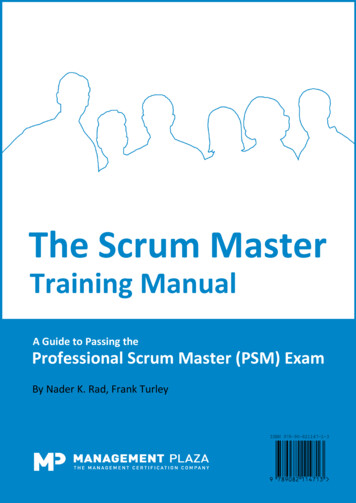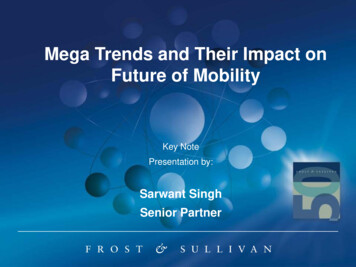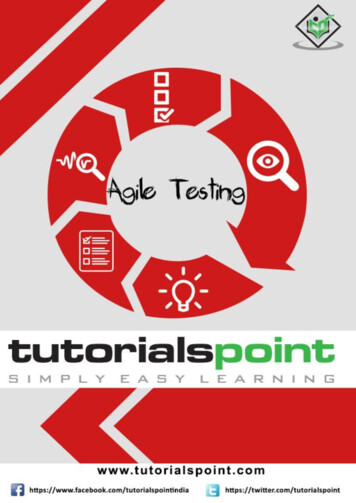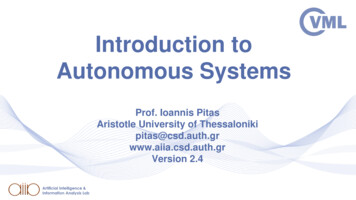
Transcription
Connected andAutonomousMobilityManifestoMarch 2021In collaboration withwww.irfnet.ch
AcknowledgmentsThis document, has been initiated by the Connected and Autonomous Mobility Committee (CAMC) ofthe International Road Federation (IRF) with the support of the European Union Road Federation (ERF)and the European Association of Operators of Toll Road Infrastructures (ASECAP). The IRF and itspartners wish to express their sincere gratitude to all those who have contributed to this document,either through their participation in the Committee meetings, by providing valuable inputs, and througheditorial and other support.Editorial TeamBin RAN - University of Wisconsin (UW) / China Highway Transportation Society (CHTS)Christoph BERGDOLT - SWARCODickson LEOW - Australian Road Research Board (ARRB)Evangelos BEKIARIS - Centre for Research and Technology Hellas (CERTH)Harald MOSBÖCK - SWARCOLaura COCONEA - SWARCONikolaos EFSTATHOPOULOS - IBI GROUPMatina LOUKEA - Centre for Research and Technology Hellas (CERTH)Rik NUYTTENS - European Union Road Federation (ERF) / 3MVenkat NALLAMOTHU - American Association of State Highway and Transportation Officials (AASHTO)Special thanks toForewordThe transport sector is facing many challenges that will revolutionize the way societyinteracts with the mobility ecosystem. Roads, as always, are a fundamental piece ofthat ecosystem, allowing interaction with vehicles and road users. Therefore,anticipation and preparation are critical to guarantee that all road-relatedstakeholders have the most sustainable, efficient, safer and cleaner mobilityservices.This Manifesto's main objective is to provide the basis for discussion to proactivelyprepare ourselves for the mobility revolution that Connected and AutonomousVehicles (CAV) bring to our sector. Understanding the challenges that come with thedigital revolution, ahead in advance, will allow us to better plan, to evaluatealternatives and to come up with solutions, right from the start, to obtain relevantresults and to improve the transportation system as a whole.We want to express our gratitude and that of our Federation to our partners whohelped us produce this document and thank the IRF Secretariat people whomanaged its production. All this work wouldn't be possible without them.We hope that by reading the next pages, you find the motivation to join us topromote sustainable mobility for all.Christophe NICODÈME - Director General, European Union Road Federation (ERF)Malika SEDDI - Secretary General, European Association of Operators of Toll Road Infrastructures (ASECAP)Editing and SupervisionGonzalo ALCARAZ - International Road Federation (IRF)Sam Sam DUALE - International Road Federation (IRF)Photograph and illustration creditsFront cover: Photo by Denys Nevozhai on UnsplashBack cover: Photo by CHUTTERSNAP on UnsplashPublisherInternational Road FederationChemin de Blandonnet 21214, Vernier/Geneva, SwitzerlandTel. 41 22 306 02 60, info@irfnet.chwww.irfnet.chDisclaimer – Thecontents and opinions presented in thispublication are the responsibility of the IRF Connected and Autonomous MobilityCommittee and partner ionalRoadFederation
The Manifesto in a nutshellAbout CAMCCongested cities, inadequate public transport, unsafe roads, pollution, and high vehicle acquisitioncosts all point to the urgent need to rethink mobility. The introduction of technologies related toconnectivity, automation, electrification, and digital innovation is challenging and transforming adynamic and ever-changing transportation sector.A challenging and exciting transformation of the transport sector is occurring nowadays due torapid technological advancements. This latter transformation is characterised by an equallychallenging transitional period towards a new ecosystem.While digital technologies can provide the transport sector with unprecedented instrumentstowards a sustainable future, they also present a host of new challenges as we shift towards newmobility models. The car industry is currently under pressure: new forms of ownership (sharedmobility), e-vehicles (decarbonisation), forced a modal shift to rail and waterways, user-pays andpolluter-pays cost allocation schemes, and changes in urban mobility.While most progress and debate around these issues are centred on vehicles, it is becomingevident that the road infrastructure sector will play a significant role. Our sector must ensure thatall the relevant parts of this new ecosystem work harmoniously in the same direction to provideseamless, safe, efficient, and sustainable transport.The International Road Federation (IRF), based in Geneva - Switzerland, with a history of more than70 years and on the forefront of every form of transformation of road transport, launched theConnected and Autonomous Mobility Committee (CAMC) to respond to our society's extensivechallenges.The joint committee led by the International Road Federation (IRF), with the support of theEuropean Union Road Federation (ERF) and the European Association of Operators of Toll RoadInfrastructures (ASECAP), aims to build a shared vision that will guide the upcoming transitionperiod towards a mixed-traffic scenario, i.e. conventional and autonomous vehicles.This Manifesto summarises the initial discussions about the main challenges of the threemain workstreams guiding the committee work.The International Road Federation (IRF), along with key strategic partners in the road infrastructuresector, launched the Connected and Autonomous Mobility Committee (CAMC) to address thesetopics.The Committee's mission is to define the road infrastructure sector's role, vision, and challenges inthis transition period towards cooperative, connected and autonomous mobility.ObjectivesRegulatory frameworkThe lack of adequate physical road infrastructure hinders our sector's ability to achievehigher autonomous driving levels. Over time, digital infrastructure will enhance physicalinfrastructure and create a safe and robust operational design domain (ODD) incooperation with the intelligent vehicle. It is crucial to develop meaningful performancebased norms, standards, and specifications in a public procurement world.Build a shared vision regarding the road infrastructure sector's role during theupcoming transition period of mixed-traffic scenario, i.e. conventional andautonomous vehicles.Facilitate cooperation between private and public sectors to ensure a high level ofsafety, efficiency, and sustainability in the road infrastructure sector.Future workforce and social needsThe challenges of automation, new technology and the future of work are some of themost critical issues that workers are facing today. Automation and technologicaladvances undoubtedly present challenges, but also opportunities. To this extent, thepublic and private sectors require guidance and support about future staff needs androles in how both sectors should work together to maximise connectivity andautomation benefits.Technological innovationsThe implementation of evolving technological trends has started in many segments of thetransport chain. Despite significant advancements, the deployment of autonomous vehiclesremains a challenge. Additionally, there is limited research regarding the improvement ofroad infrastructure to serve smart vehicles. Hence, developing an autonomous drivingsystem that includes an engineering approach should cover all essential entities, vehicles,infrastructure, and the management system. This workstream addresses the concept ofconnected infrastructure, built on digitalisation elements, and the availability of relevantstatic and dynamic information.Provide input and guidance towards ongoing processes and initiatives.Get involvedThe Committee is open to IRF members, road operators, technology providers, researchinstitutions, national and regional authorities, associations, and other organisations uponinvitation.If you think you can bring value to the CAMC work , please write to info@irfnet.ch
CAMC workstreams challengesRegulatory frameworkWithout an adequate physical road infrastructure1, our sector cannot achieve higher levels of autonomous driving. Gradually, digital infrastructure will complement physical road infrastructure and assistin creating a safe and robust Operational Design Domain (ODD) that aligns with the intelligent vehicle.These ODD's will create growing islands for specific use cases of higher SAE levels2. Technical requirements and related KPIs will be embedded in safety, harmonisation, standardisation, and interoperability.This regulatory framework will be the economic model's backbone for the road equipment supplier,contractor, and road operator. It is crucial to develop meaningful performance-based norms, standards, and specifications in a public procurement world. Today the detection of road safety equipment,such as road markings, traffic signs, bollards, and delineation of work zones, is based solely on the human eye's visibility.The fast penetration of Advanced Driver-Assistance Systems (ADAS) based vehicles requires thesenorms to cover a machine vision dimension as well. By 2024 the EU General Safety Regulation3 will mandate all new vehicles to assist the driver with various ADAS, including lane-keeping, adaptive cruise control and intelligent speed assistance. Studies have illustrated that road markings' optimal detection under different weather conditions, a lane-keeping or departure warning system could reduce up to 30%of head-on or single-vehicle crashes.Not all sensors depend on visible light; Lidar moves into the near-InfraRed (IR) domain, and radar evenfurther away from the visible light, which moves performance-based standards and Key PerformanceIndicators’ into unknown territory. Digital infrastructure will duplicate the physical infrastructure by creating a digital High-Definition (HD) map, preferably with real-time updates. It will also offer an array ofsmart and safe mobility applications: traffic and asset management, emergency response as the essential services, even toll collections in the toll road domain. In the future, it will also assist in achievinghigher levels of automation4.Each of these applications or services requires a harmonised launch worldwide with an uninterruptedcross border transition. Hence, the role of the United Nations Economic Commission for Europe (UNECE)5 to create standards and regulations for vehicles, infrastructure and telecommunication .Challenges and related actionsA. The difference in speed of the technological evolution between the road infrastructure andthe vehiclesProduct life cycles and execution in both areas are not in-sync and will never be. Although infrastructureis needed to safely move towards higher automation levels, the automotive industry illustrates theincapability to wait; nevertheless, it still requires infrastructure to support a safe system or ODD.Furthermore, the technical characteristics of both deployment stages are quite different. Compared tothe autonomous driving industry's technological development speed, the legislation of relevant lawsand regulations is lagging.Currently, the issued policies and regulations are mainly based on road test specifications forautonomous vehicles and industry standards. There is no substantial progress in revising the existingroad traffic safety law, privacy protection, and network information security.1 es/2017-09-c-its-platform-final-report.pdf2 https://www.sae.org/standards/content/j3016 201806/3 https://ec.europa.eu/transport/road 8-adas.pdf4 /sc1/ECE-TRANS-SC1-S-Present-2018-5e.pdf5 https://www.unece.org/trans/main/sc1/sc1.htmlB. Public sector difficulties in dealing with the innovation of new infrastructure investments.Innovative solutions do not comply with the traditional public procurement process as defined byvarious standardization bodies, and other norms only cover the "known" products. New technologycommonly starts with a single supplier and lacks the "peace of mind" offered by the "traditional way".However, it is crucial to establish a framework regarding relevant regulation surrounding product andmarket entry, infrastructure construction, transportation market management, privacy, and security.Government bodies and professional societies should actively promote, develop, and revise relevantlaws and regulations to better adapt to the autonomous driving era's needs. This latter will ensure thatthe various digital infrastructure solutions are not overwhelming for the traditional road operator.C. Data generation and ownershipVehicle and infrastructure sensors, mobile devices generate enormous amounts of data that could betransformed into valuable information for the consumer and road owner—leading to new businessmodels and new players. "Data is the new oil".D. A financial ecosystem that invests in the entire industrial chainRelevant technologies cover various areas such as electrical, communications, manufacturing, andinternet industries, in which the applications and experiments of new technologies will continue toappear. Participants should actively use the industry's resources to form a functional ecosystem,facilitating the industry to explore and recommend high-quality projects and investment opportunities.E. The level of automation is complex for road authorities to mandate specific rules orlegislationsSome embedded bills are difficult to change as they interlink with other regulations, e.g. road rules withparking regulations. In the United States, legal, regulatory, and executive authority for autonomousvehicles resides primarily within each state. As a result, an array of arrangements has taken shapeacross the country to govern autonomous vehicles' allowance on public roads and the way they aredeployed.These arrangements vary from state to state, both in terms of what legal mechanisms are employed(state law, regulations, executive orders, general policy or some combination) and the level of detailprescribing permissible actions.Additionally, the lack of cooperation between the automotive industry and (physical) infrastructurecreates an additional barrier. The automotive industry prefers to have a solution that may be"infrastructure-independent". The fierce competition between the different vehicle manufacturerscreates contrasting propositions towards the consumer, i.e. "my car is more reliable and has a higherlevel of autonomy".The industry is also aware that not all roads can be upgraded to the same level. Given the dynamicnature of the field and constant advances in technologies, these frameworks become outdated rapidlyand can hinder the practical piloting and mainstreaming of technologies.Furthermore, the vast array of approaches taking shape across the states offer a laboratory ofexperimentation to learn from one another, rather than become a national deployment barrier. Thislatter calls for knowledge sharing among states to help inform the more mature development oflegislative and regulatory frameworks intended to govern autonomous vehicles. Hence, the need todevelop a balanced and regulatory framework that provides appropriate boundaries to test unproventechnologies while also providing room for outcomes of new technologies and practical solutions.F. The law has to be changed: the responsibility for driving does not rest with a human anymoreRoad infrastructure must conform to the minimum requirements of being readable by connectedvehicles (e.g. road markings, road signs, road surface). The signalisation of road works should beharmonised and traffic codes across the globe should become more and more comparable andinteroperable.
Future workforce and social needsSpecific technological trends, including automation, are expected to cause and drive essentialtransportation sectors' fundamental changes. Simultaneously, they are expected to have significantsocietal implications on the sector's employment and workers' qualification. The discussion on theimpacts of automation naturally leads to a debate regarding their long-term effect on the transportlabour market, job quality, and economy.There have been several debates regarding the future of transport and the implications for humancapital. On one end, machines may substitute a significant rate of workers (both low and middle-skilled)in different positions and tasks, leading to technological unemployment and breakdowns in the socialorder.On the other hand, some visualise a future where human creativity will continue creating new jobs andestablishing further cooperation between humans and machines. Automation affects all transportmodes, including remotely controlled vessels, driverless trucks, cars and trains, autopilot onaeroplanes, drones for logistics delivery. Transport is a significant jobs provider in Europe (1 out of 20jobs - 5% of the labour force) and an ageing sector (with 1/3 of its workers over 50 years old lackingappeal). Thus, automation might partially solve the lack of labour in the industry in the future.Over the last several years, NOCOE has evaluated what the future of the workforce could look like. Inthe process, developing significant resources that identify how traditional roles should evolve and hownew ones could be implemented, as well as focusing both on the professional and paraprofessionalworkforce. NOCOE has taken the organisation's Leadership and its Human Resource staff's perspectiveto identify how to determine its workforce needs, recruit and retain staff, and benefit from theeducational and training opportunities vital to keep its focus up to date.At European level, the European Commission (EC), through projects SKILLFUL and the "Study on thesocial dimension of the transition towards automation and digitalisation in transport, focusing on thelabour force" provide its approach on future workforce needs and how to reskill/upskill the workforcetowards automation requirements7.B. Overview of the training needs and suggestion of necessary training modules andprogrammesTraining content needs to be harmonised in terms of quality and delivery across various countries andregions. Training curricula should also adapt quickly to evolving technologies occurring in mostEuropean Union (EU) countries and elsewhere. However, administrative regulation hinders the quickadaptation of changes in training curricula. This result in a slow process that can take years toimplement.The variance found across tasks indicates that some industries will experience automation earlier thanothers, with passenger road transport being the most likely to be automated, while rail transport tasksbeing less prone to automation. The potential for deep-sea transport is similar to that found in airtransport. Task profiles are more diverse within the supporting activities of a specific transport mode,such as cargo handling in ports or airports.Therefore, education policies should lower administrative burdens to facilitate a fast-changingcurriculum to better adapt to jobs demand. Moreover, as diplomas become more recognised globally,there is a need for a unified training scheme certification, which should be promoted to training actorsworldwide.Supporting activities for road freight and deep-sea transport have the most significant potential forfurther task automation. In contrast, other automation is more challenging to be achieved in thesupporting activities for rail transport. To this extend significant employment increase is expected inScience, technology, engineering, and mathematics (STEM) job families, while a moderate reduction inoffice and administrative roles6.A harmonised system of accreted courses should be implemented (i.e. an automatism for registrationand yes/no answers on predefined questions for all course providers). Evaluation procedures of skillsfor diplomas abstention should be harmonised. For that to occur, universities have to work together toensure that transport diplomas obtained in any country can hold validity in other counties and worktowards a common multi-disciplinary global Master on Future Transport.To this extent, guidance and support are required for the public and private sector regarding futurestaff needs and roles on how both sectors can harmoniously maximise connectivity and automationbenefits. And above all, the COVID-19 pandemic will certainly influence changes to the workforcedynamics and mobility as we know them today.Opportunities for vocational and life-long learners to combine learning experiences acquired indifferent settings should be increased, and certification from these various experiences should beallowed and encouraged.C. Examining existing business models, and further developing new business roles, fine-tunedfor automation needsChallenges and related actionsA. A clear view of the transport labour force's challenges is the transitional phase towardsautomation and a sound understating of what information needs to be further investigatedAutomation gives rise to new jobs while making others redundant. At the same time, transformingexisting jobs and demanding new skills for emerging new tasks, resulting in a certain level of changewhere the current human capital has to be retrained or even replaced by new professionals whoalready have these skills.By 2025, patterns of work will be even more differentiated than today. In response to the shiftingdynamics, the National Operations Center of Excellence (NOCOE), and its founding association partnersof the American Association of State Highway and Transportation Officials (AASHTO), ITS America, andthe Institute of Transportation Engineers (ITE) have facilitated a robust discussion on the TransportationSystems Management and Operations (TSMO) regarding the future workforce.TSMO, in American parlance, represents the nerve centre of transportation agencies and is responsiblefor managing the agency's transportation infrastructure—across multiple modes, and accompanyingtechnologies central to the safety and mobility central to the agency's mission.New business roles (as the six suggested by the SKILLFUL project8) could dramatically change thetransportation sector's future training provision and become the catalyst for its sustainability. Forexample, as energy aggregators have paved the way for new, more efficient schemes in energyconsumption reduction in Europe; "transport knowledge aggregators" may equally become thecatalyst for a sustainable and advanced Continuous Vocational Educational Training (CVET) quality inthe transportation area.Furthermore, "transport training certifiers" and "transport training promoters" can help expandtraining schemes from local/national to European and enormously facilitate the mobility of theEuropean workforce (through recognition of their competences across different regions and workers,as well as dynamic retraining/reskilling initiatives).Additionally, the maintenance workforce will need upskililng as well as a traffic management workforce.Even at the Traffic Management Centre (TMC), the vast array of sensors and data generated will needanalytics, opening a new type of role. Insurance assessors, mechanics, driving instructors etc., will needretraining or a new role type. Lastly, autonomous vehicles should be initially authorised only onmotorways. Mixed traffic should "not exist": the autonomous vehicles should behave as "normal" ones,and human drivers should not make any "human driving" mistakes.6 World Economic Forum. (2016, January). The future of jobs: Employment, skills and workforce strategy for the fourth industrial revolution. InGlobal Challenge Insight Report, World Economic Forum, Geneva7 Relevant Paper: Bekiaris, E., Loukea, M. (2019). Skills and Training Requirements for the Future Transportation Sector of Europe. In the 16thEuropean Automotive Congress (EAEC-2019), 7-11 October 2019, Minsk, Belarus8 SKILLFUL Deliverable: D4.2: New business roles and scenarios for training in the Transportation sector
Technological innovationsTremendous efforts have been made in vehicle automation, such as developing advanced sensors andalgorithms installed on vehicles to imitate human drivers' behaviour. Despite significant progress, thedeployment of autonomous vehicles remains a challenge. Additionally, the improvement of roadinfrastructure to better serve smart vehicles is not well investigated.As we've witnessed the development of modern highways in the early twentieth century in response tothe rapid increase in the use of modern automobiles, it's intuitive to wonder what the next generationof cars and road systems will resemble. Currently, Connected Vehicles (CV) and Autonomous Vehicles(AV) are largely progressing on separate paths. AVs will be safer and more effective when connectedwith the infrastructure. For this to occur, the focus needs to be on the convergence of CVs and AVs, andsystem components, especially automation of vehicles and infrastructure.1.2. Evaluation methods of the three core issues of transportation: efficiency, safety, and environment,in the context of technical characteristics of autonomous driving; and3. Analysis of industry expansion and its effect on autonomous driving, focusing on innovativebusiness created jointly by different stakeholders (e.g. traditional transportation engineeringcompanies, internet companies, telco operators, and the high-precision map companies).With the improvement of the performance evaluation system for CAV, CAH, and CAVH and theincreasing development of technology applications, the autonomous driving system has transformedfrom a vehicle-centric intelligent system to a vehicle-road collaborative smart system.Many intelligent systems between vehicles and road infrastructure are connected, causing complexityin implementation, also increasing requirements for the formulation of relevant industrial and technicalstandards.Hence, the need to develop an autonomous driving system that includes an engineering approach,covering all essential entities, the vehicle, the infrastructure, and the management system. In thiscontext, a system oriented approach that covers all significant categories of traffic entities is needed tobuild coordinated and interconnected transportation operations and control systems. Instead offocusing solely on "smart" vehicles, the CAMC aims to establish the seamless collaboration of smartvehicles and smart infrastructure, towards an ecosystem for "Smart Vehicle, Smart Road, and IntelligentSystem."Currently, standards systems related to ADS in general, and CAV, CAH, and CAVH lack clear and detailedsystem design and classification, causing obstacles to the industrialisation and application of relatedtechnologies.In short, CAMC aims to enable and support a general Autonomous Driving System (ADS), andspecifically promote the integrated development of Connected Autonomous Vehicle (CAV) andConnected Autonomous Highway (CAH), namely a Connected Autonomous Vehicle Highway (CAVH)System.B. Common Technology Innovations and Key Technology BreakthroughsFurthermore, the need to adapt the existing road infrastructure and deploy new technologies to evolvefor autonomous driving and transport is likely increasing as the SAE automation level increases.Additionally, SAE L3 functions may already have impacts on the efficiency of the transport system. Aswe've shifted towards levels 4-5, the adaptation of physical infrastructure and its link with the digitalinfrastructure is becoming a vital issue for deploying connected and autonomous vehicles. In thiscontext, connectivity between infrastructure and vehicles is critical to ensure adequate operationalconditions.This workstream address the concept of connected infrastructure, built on digitalisation elements, andthe availability of all relevant static and dynamic information. The next step presented here is relatedto collaborative schemes of traffic management, significantly improving the road network throughputperformance exploiting this 2-way communication, then interaction, with single vehicles driving on theroad. For this reason, a minimum set of data needs to be shared between vehicles and infrastructureto ensure a seamless travel experience.Collaborative traffic management will be the only way to create the quality-of-service conditions andthe planned travel time's reliability. Hence, technological upgrade of road infrastructure represents aprerequisite for successful autonomous driving deployment.Challenges and related actionsInfrastructure needs to handle connected and autonomous vehicles of variable degrees of autonomyand non-connected vehicles. It is crucial to prepare a roadmap for the safe introduction and roll-out ofCAVs and associated infrastructure upgrades required, considering the conditions of mixed CAVs andnon-connected vehicles for both passenger and freight transport.A. Technical Standards and Effectiveness Evaluation SystemA systematic effectiveness evaluation can facilitate the system optimisation of autonomous drivingsystems. Considering the following aspects:1. Efficiency calculation methods for intelligent network connection and communication, autonomousdriving, and various supporting technologies;Meanwhile, industry development requires the formation of national technical standards for sensors,network communications, high-precision maps and applications, network security and informationservices, high-level autonomous vehicle product certification, and life cycle supervision.The development of ADS and CAVH Systems involves many technical fields, including connectedautonomous highway, connected autonomous vehicle, communication, cloud and edge computing,high-precision map, high-precision location, requiring a high degree of integration and application ofrelated technologies.The guiding principles t
Road infrastructure must conform to the minimum requirements of being readable by connected vehicles (e.g. road markings, road signs, road surface). The signalisation of road works should be harmonised and traffic codes across the globe should become more and more comparable and interoperable. Regulatoryframework CAMCworkstreamschallenges










